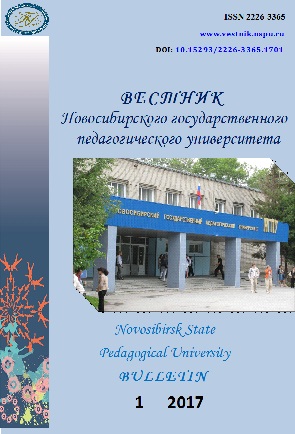Динамика морфофункционального состояния
школьников 6–7 классов в процессе учебного года
в зависимости от организации физического воспитания
Dynamics of morphofunctional state of 6 th –7th form schoolchildren in the academic year, depending on the organization of physical education
Author(s): Nikolay V. Yachmenev, Viktor Borisovich RubanovichSubject(s): School education, Health and medicine and law, Sociology of Education
Published by: Новосибирский государственный педагогический университет
Keywords: Physical education of children; cycle and traditional organization; physical education lessons; physical development; functional condition; physical working capacity;
Summary/Abstract: Introduction. Inconsistent data about influence of physical training lessons on health, physical development and physical readiness of children and teenagers are caused by use of various techniques to the organization of educational activity. Purpose – to study the dynamics of morphofunctional state of 6–7 grade schoolchildren within an academic year at the cyclic and traditional organization of physical training lessons. Materials and Methods. Two groups of 6–7 grade schoolchildren of the basic medical group which are engaged in physical training (experimental group, EG – 17 persons; control group, CG – 25 persons) have been studied. In the EG the annual academic load of physical training was distributed on 4 cycles and the intercyclic periods for 4–5 weeks each. During the periods of cycles there were 5 lessons in a week, and during the intercyclic periods – 2 lessons in a week. Pupils of CG were engaged in physical training traditionally on 1 hour 3 times per week. The authors studied the anthropometrical (length and weight of a body, a thorax grasp) and functional parameters (the brush muscular force, vital capacity of lungs, a vital index, resistance to air insufficiency – Stange’s and Gench’s tests, cardiac rate and arterial pressure in conditions of rest and standard step-ergometric physical capacity, circulatory-respiratory Skibinsky’s coefficient. The physical performance was evaluated due to the PWC170 test. The examination of the EG schoolchildren were held before and after every cycle, the same time as the boys from CG. Results. It was established that during the school year the pupils from EG in comparison with the ones from CG had an increased muscular strength, a better outer lung capacity and cardiovascular system, an enhanced physical work capacity. During the school year after cy-cles with high concentration of physical training lessons in EG an improvement of the parameters under study was observed; by the end of academic year for many of them the differences were significant in relation to initial data. In the end of intercycle periods a small loss of cumulative effect after the prior cycles was found. The schoolchildren of CG did not have any significant changes in the studied indicators of physical health on all stages of research. Conclusions. It was observed that the teenagers of experimental group increased substantially their muscular force, functional reserves of cardiorespiratory system and physical working capacity. During the intercyclic periods at reduction of lessons till 2 o'clock in a week the tendency to decrease in some functional indicators was detected. Essential changes of the studied parameters of physical health at schoolboys of control group in the course of an academic year it was not revealed.
Journal: Вестник Новосибирского государственного педагогического университета
- Issue Year: 7/2017
- Issue No: 1
- Page Range: 191-202
- Page Count: 12
- Language: Russian

